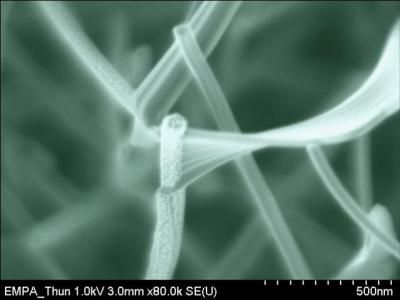Outstanding Results on Research in Synchrotron Radiation rewarded
At the "First Joint BER II and BESSY II Users' Meeting" on November 12th / 13th the "Freundeskreis Helmholtz-Zentrum Berlin e. V." bestowed the "Ernst-Eckhard-Koch-Prize" and the "Innovation-Award on Synchrotron Radiation" for 2009.
Dr. Stephen Peter Berkebile from the Karl-Franzens-Universität Graz received this year's "Ernst-Eckhard-Koch-Prize" for the outstanding results of his doctoral thesis. In his thesis the 33-year old scientist investigated the growth of organic films with different spectroscopic methods at BESSY II to obtain detailed results on the electronic band structure of the individual layers. Thus, his thesis described new findings concerning charge transport in molecular thin films. These findings are important for the further development in organic electronics, such as transistors or LEDs consisting of organic materials as well as for organic solar cell technology.
The "Ernst-Eckhard-Koch-Prize" is bestowed for an outstanding doctoral thesis in the field of research with synchrotron radiation performed at either BESSY II or HASYLAB, Hamburg, completed during the current or past year. The prize includes a monetary award amounting to 2,500 Euro.
The 2009 "Innovation-Award on Synchrotron Radiation" was awarded to a team of scientists from the optical systems department of the HZB. Heiner Lammert, Tino Noll, Frank Siewert and Thomas Zeschke developed an Ultra-Precision Measuring-Machine for optical surfaces. With their Nanometer Optical Component Measuring Machine (NOM) they had established a completely new measuring principle: autocollimator-based-nano-deflectometry for optical metrology. With the new device experts can measure mirrors on the sub-nanometer scale - a very important requirement for manufacturing ultra-precise optical surfaces. Optical components such as reflection mirrors and gratings are needed to produce and focus monochromatic synchrotron radiation. At a synchrotron radiation facility like BESSY II more than 200 of such crucial optical elements are in use. The quality of synchrotron radiation depends critically on the accuracy of the optical components.
The measurement power of NOM corresponds to detecting a pinhead on an absolutely plane surface of the size of Portugal. Compared to previously obtainable data this accuracy is a quantum jump; staying within the Portugal picture: before the "NOM era" the measurement limit on the same surface area corresponded to a mole hill. Due to the unprecedented accuracy NOM has become a kind of reference standard. Metrology instruments developed at other synchrotron radiation facilities are aligned with respect to the NOM. A licensed replica is in operation at the Diamond Light Source in the UK. Moreover, many scientific cooperation partners like DESY or commercial optics manufacturers like Carl ZEISS AG are using the ultra-precision measuring-machine.
The "Innovation-Award on Synchrotron Radiation" is announced Europe-wide for an outstanding technical achievement or experimental method that promises to extend the frontiers of research with synchrotron radiation. It includes a monetary prize of 3,000 Euro sponsored by SPECS GmbH and BESTEC GmbH.
Most read news
Topics
Organizations
Other news from the department science

Get the analytics and lab tech industry in your inbox
By submitting this form you agree that LUMITOS AG will send you the newsletter(s) selected above by email. Your data will not be passed on to third parties. Your data will be stored and processed in accordance with our data protection regulations. LUMITOS may contact you by email for the purpose of advertising or market and opinion surveys. You can revoke your consent at any time without giving reasons to LUMITOS AG, Ernst-Augustin-Str. 2, 12489 Berlin, Germany or by e-mail at revoke@lumitos.com with effect for the future. In addition, each email contains a link to unsubscribe from the corresponding newsletter.



















































